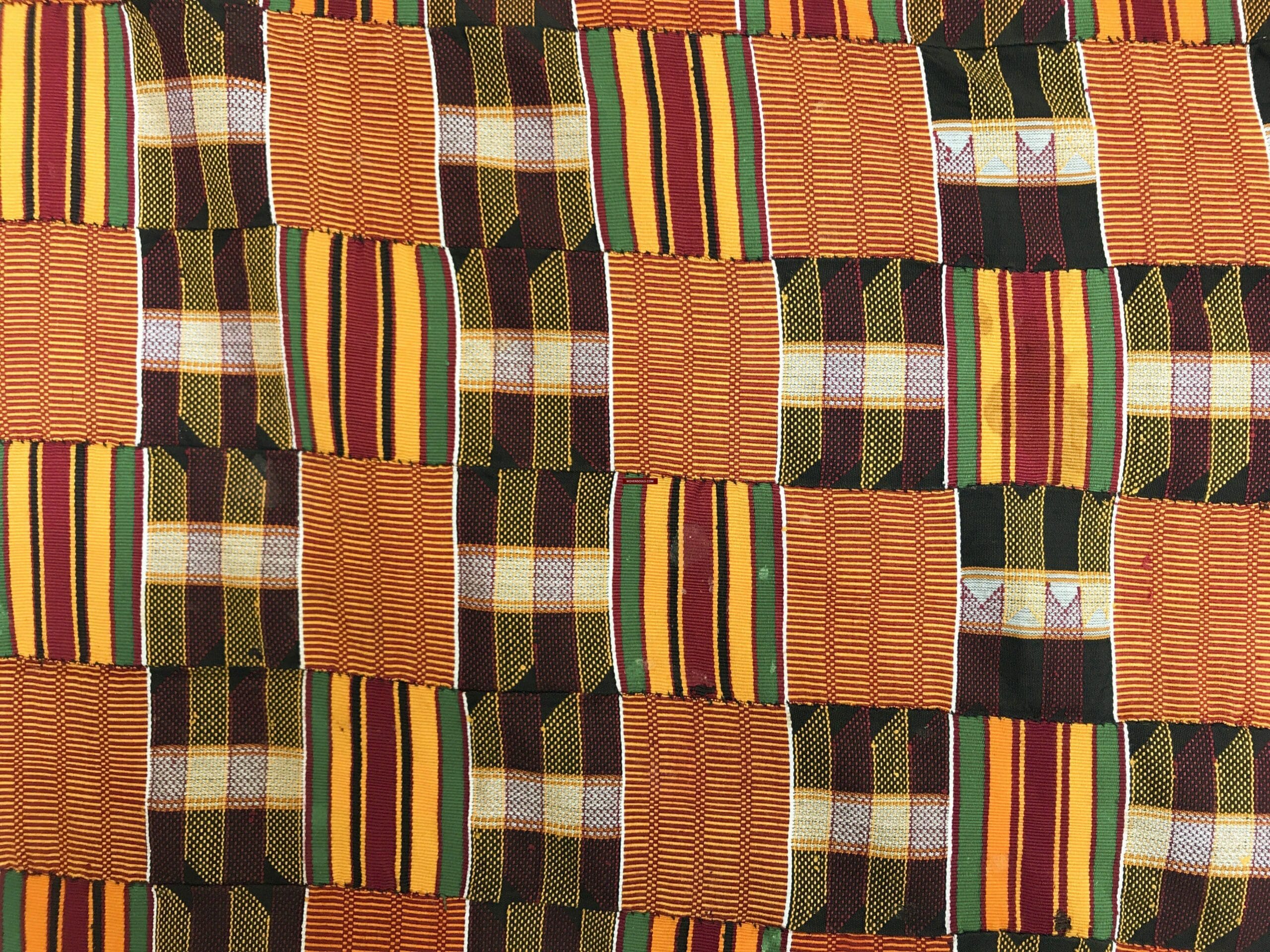Kente cloth, a vibrant textile originating from Ghana, pulsates with rich history and cultural significance. More than mere fabric, it serves as a visual language, narrating stories of heritage, status, and belief through intricate patterns and a dazzling array of colors. From its royal origins to its modern-day resurgence, kente cloth continues to captivate and inspire. Let’s unravel the threads of meaning woven into this extraordinary textile.
A Vibrant History Woven in Threads
Kente cloth’s origins lie within the Asante and Ewe communities of Ghana, where it has been treasured for centuries. Likely originating as early as 1000 BCE with the Akan people of the Ivory Coast and later adopted by the Ewe people, kente’s journey reflects the dynamic interplay of culture and history. This “living tapestry” connects past generations to the present, each pattern a word or phrase in a complex visual vocabulary. These symbolic designs can represent anything from historical events and philosophical concepts to proverbs, social status, and even personal experiences.
The Art of the Loom
Creating kente is a meticulous art form. Traditionally woven by men on narrow strip looms, approximately 4 centimeters wide, the process is intricate and time-consuming. These narrow strips are then carefully sewn together to create the larger cloth, resulting in the distinctive geometric and often repeating patterns characteristic of kente. This labor-intensive technique contributes to the cloth’s inherent value and suggests a deep connection to the spiritual realm. The very structure of the cloth, with its interwoven strips, speaks to the interconnectedness of community, history, and belief.
A Rainbow of Symbolism
The vibrant colors of kente are far from arbitrary. Each hue carries symbolic weight, enriching the already intricate patterns. Gold, often associated with royalty and spiritual purity, suggests wealth, prestige, and the presence of the divine. Green, representing growth, fertility, and renewal, symbolizes the life-giving power of nature. Red, a powerful color associated with blood, sacrifice, and spiritual energy, can also represent political and spiritual moods, even bloodshed. While these interpretations are generally accepted, regional variations and individual interpretations exist, adding to the richness and complexity of kente’s symbolism. Do you want to know more about the indigenous people of the Pacific Northwest? Read more about them here.
Decoding the Language of Kente
Kente cloth patterns are more than just beautiful designs; they form a sophisticated system of visual communication. Each pattern tells a story, whispering secrets of the Ashanti and Ewe people. This intricate language incorporates geometric shapes, symbolic motifs, and a spectrum of colors, each element representing something important to these communities – their history, beliefs, and values.
Patterns with a Purpose
Let’s explore some well-known kente patterns. “Adwinasa,” meaning “all motifs used up,” suggests the weaver’s mastery, akin to a painter utilizing every color on their palette. “Sankofa,” depicting a bird looking back, reminds us to learn from the past. “Dwennimmen,” a ram’s horn, embodies strength and determination. “Emaa Da,” meaning “it won’t happen again,” celebrates resilience, often associated with women. “Nsaa,” with alternating dark and light squares, symbolizes excellence and knowledge. “Nyansapo,” an intricate knot, represents wisdom and intelligence. These examples, among hundreds of others, offer a glimpse into the rich vocabulary of kente.
| Pattern Name | Meaning | Symbolism |
|---|---|---|
| Adwinasa | “All motifs used up” | Mastery of weaving, complexity |
| Sankofa | Bird looking back | Learn from the past |
| Dwennimmen | Ram’s horn | Strength, courage, determination |
| Emaa Da | “It won’t happen again.” | Resilience |
| Nsaa | Alternating squares | Excellence, knowledge |
| Nyansapo | Intricate knot | Wisdom, intelligence |
A Reflection of Identity
Kente cloth also reflects the wearer’s identity – gender, social status, clan affiliation, and geographic region. Certain patterns might be associated with royalty or specific occasions, adding another layer of complexity. While some interpretations are widely accepted, research continues, and some experts believe interpretations can differ.
Unraveling the Sacred Threads: Kente’s Spiritual Significance
Kente cloth’s spiritual significance runs deep, connecting the wearer to their ancestors, community, and the divine. Each carefully crafted pattern and vibrant color whispers stories of cultural heritage, personal experience, and a profound connection to the spiritual realm.
Colors Imbued with Meaning
The dazzling colors of kente hold significant meaning. Gold might symbolize royalty and spiritual purity; black, spiritual strength or mourning; green, growth and renewal; blue, peace and harmony; and red, political passion or sacrifice. These meanings may vary regionally, highlighting the dynamic nature of cultural interpretation.
Patterns as Spiritual Narratives
The intricate patterns enhance the spiritual narrative. “Adwinasa” symbolizes wisdom and mastery, representing a journey completed. Other patterns may represent proverbs, historical events, or abstract concepts like hope and unity. Some believe that wearing kente offers spiritual protection, acting as a shield against negative energies. This belief speaks to kente’s profound significance – it’s not merely clothing, but a spiritual armor.
Who Wears Kente? A Cloth with Evolving Significance
Historically, kente was largely associated with Ghanaian royalty and nobility, particularly within the Ashanti Kingdom. This exclusivity underscored its prestige and symbolic power. Today, however, kente’s reach extends far beyond its origins.
A Symbol of Heritage and Pride
For Ghanaians, kente remains a powerful symbol of pride and cultural identity. It’s a tangible link to their ancestors and a vibrant expression of their heritage. However, kente’s striking beauty and rich symbolism have captured the attention of fashion lovers and art enthusiasts worldwide.
Navigating Cultural Appreciation
This broader adoption raises important questions about cultural appreciation versus appropriation. Some argue that wearing kente without a genuine connection to Ghanaian culture can diminish its significance. Others suggest that appreciating its artistry can foster cross-cultural understanding. There’s no single answer, and the conversation continues to evolve. For those outside the Ghanaian community considering wearing kente, learning about its history and significance is crucial. This demonstrates respect and allows for a deeper appreciation of its cultural weight.
Kente in the Modern World: A Renaissance of Tradition
Kente’s influence is expanding beyond traditional uses. From high fashion runways to home décor, designers draw inspiration from its vibrant patterns, giving them new life in contemporary creations. This global embrace introduces kente to a wider audience while also raising important ethical considerations.
Preserving Cultural Heritage
Supporting traditional artisans is vital, not only to preserve their livelihoods but also to ensure the authentic techniques and cultural significance of kente are maintained. Organizations dedicated to cultural preservation play a crucial role in educating the public and promoting appreciation worldwide.
Ethical Considerations in a Globalized World
The increasing popularity of kente requires careful consideration of ethical implications. Avoiding cultural appropriation and promoting fair trade practices are key to ensuring its continued vibrancy and protecting the legacy of the artisans who create it. Ongoing research and open dialogue are crucial for navigating the complexities of cultural exchange in a globalized world. As kente gains international recognition, it is essential to ensure its cultural heritage is respected, protected, and celebrated authentically.
- Striped Raphael Catfish: The Complete Care Guide (Tank Setup, Diet & More) - November 23, 2024
- Decoding the Ticked Tabby Kitten: Unveiling Their Unique Coat & Care - November 23, 2024
- Coulterville, IL: A Small Town with a Big Heart in Randolph County - November 23, 2024
















1 thought on “Woven Threads of Meaning: Exploring the History, Symbolism, and Modern Renaissance of Kente Cloth Patterns”
Comments are closed.